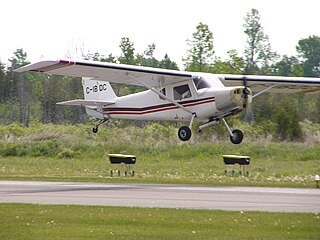Related Research Articles
The Advanced Aviation Explorer is a two-seat ultralight marketed in kit form, for amateur construction. It is a high-wing taildragger aircraft of pusher configuration with tandem seating.

The Weedhopper is an American high-wing, tractor configuration, tricycle gear, two-axis control ultralight aircraft originally developed by John Chotia during the height of the 1970s ultralight boom and introduced in 1977. When it was in production the aircraft was sold as a kit for amateur construction and could be assembled in 25-30 man-hours.

The Avenger is a single-seat, Canadian low-wing, tractor configuration ultralight aircraft. The Avenger was introduced in 1994 and is available as a kit or as plans from Fisher Flying Products.
The Adams CA-2 is a single seat, low-wing, American ultralight aircraft that was designed by Frank Griffith of Corning Aircraft around 1992 and was available as plans for amateur construction until 1999. In 1999, Hummel Aviation of Bryan, Ohio began offering the design. Although the design was well received, plans were no longer listed as being available from Hummel Aviation as of 2007.
The Avid Champion is an American single-seat, high-wing ultralight aircraft that was produced starting in 1998 as a kit by Avid Aircraft of Caldwell, Idaho, later Ennis, Montana.
The Ameri-Cana Eureka is a Canadian designed and built low-wing, single seat, conventional landing gear-equipped ultralight aircraft that was produced as a kit by Ameri-Cana Ultralights of Irricana, Alberta between 1997 and 2003.
The Airdrome Dream Classic is a minimalist, high wing, single seat, single engine ultralight aircraft inspired by the 1908 Santos-Dumont Demoiselle and produced in kit form by Airdrome Aeroplanes of Holden, Missouri.
The Chotia Gypsy is an American single engine, high-wing, conventional landing gear-equipped ultralight aircraft that was designed by John Chotia in 1980.
The Wings of Freedom Flitplane is an American single-seat, high-wing, single-engine ultralight aircraft that is available as a kit aircraft or as plans for amateur construction from Wings of Freedom of Hubbard, Ohio.
The Fisher FP-303 is a Canadian single-seat, low wing, conventional landing gear, single engined light kit aircraft designed for construction by amateur builders. Fisher Flying Products was originally based in Edgeley, North Dakota, USA but the company is now located in Woodbridge, Ontario, Canada.
The Freebird I is an American single-seat, high wing, tricycle gear, single engined pusher configuration ultralight kit aircraft designed for construction by amateur builders by the Freebird Airplane Company of Marshville, North Carolina and later also produced by Pro Sport Aviation of Wingate, North Carolina.

The Team Mini-MAX is a large family of single-seat, mid-wing, strut-braced, single engine aircraft, available in kit form for amateur construction. The first Mini-MAX had its first flight in 1984. Its name indicates its original design goals: a minimum-cost aircraft that requires a minimum of building space, time and skill, but which provides a maximum of enjoyment and performance.

The Murphy JDM-8 is a Canadian single-seat ultralight monoplane designed by Daryl Murphy. The type was intended to be sold as a kit for home construction by Murphy Aircraft of Chilliwack, British Columbia.

The Ultravia Pelican is the name given to two series of high-wing, single-engine, tractor configuration ultralight aircraft that were designed by Jean Rene Lepage and produced in kit form for amateur construction by Ultravia Aero International of Mascouche, Quebec and later Gatineau, Quebec.

The Mitchell Wing A-10 and T-10 are a family of American cantilever, tricycle landing gear, high-wing, pusher configuration, one and two seat ultralight aircraft designed for amateur construction or supplied as completed aircraft. The aircraft were designed by Don Mitchell and were produced by a number of companies, the last being AmeriPlanes of Truro, Iowa.

The Titan Tornado is large family of cantilever high-wing, pusher configuration, tricycle gear-equipped kit aircraft manufactured by Titan Aircraft of Austinburg, Ohio for amateur construction.
The Precision Tech Fergy F-II B is a two-seat side-by-side, conventional landing gear, strut-braced, high-wing, pusher configuration ultralight aircraft that was manufactured by Ferguson Aircraft and later Precision Tech Aircraft in kit form for amateur construction. The aircraft is out of production and no longer available.
The Howland H-3 Pegasus is an American ultralight aircraft that was designed by Bert Howland and made available by Howland Aero Design in the form of plans for amateur construction, with kits provided by Aircraft Spruce & Specialty Co. The H-3 first flew in 1988.
The Six Chuter SR7 is an American powered parachute that was designed and produced by Six Chuter of Yakima, Washington, introduced in 1997.

Leading Edge Air Foils LLC, usually called LEAF, is an American aircraft parts supplier based in Lyons, Wisconsin. It is a US limited liability company.
References
- 1 2 3 4 Cliche, Andre: Ultralight Aircraft Shopper's Guide 8th Edition, page B-17. Cybair Limited Publishing, 2001. ISBN 0-9680628-1-4
- ↑ Downey, Julia: 1999 Kit Aircraft Directory, Kitplanes, Volume 15, Number 12, December 1998, page 36. Primedia Publications. ISSN 0891-1851
- 1 2 3 Stark, Wilf (July 2003). "Eureka by Ameri-Cana Ultralights" . Retrieved 26 September 2009.
- ↑ Stark, Wilf (July 2003). "Performance Specifications" . Retrieved 26 September 2009.